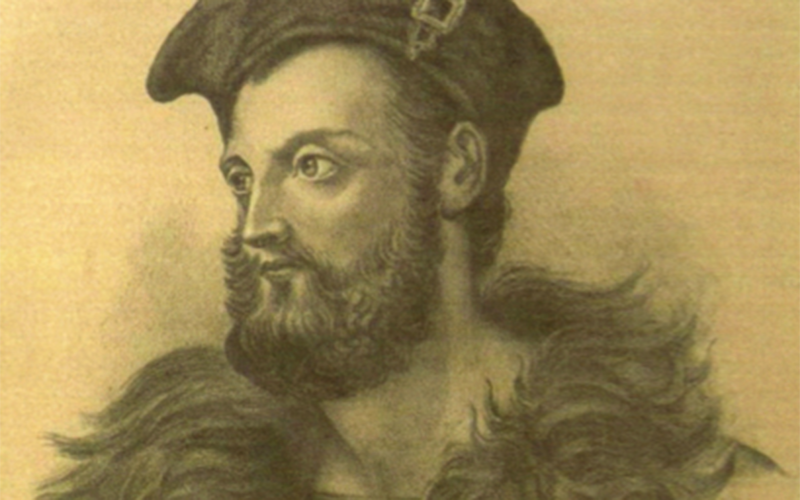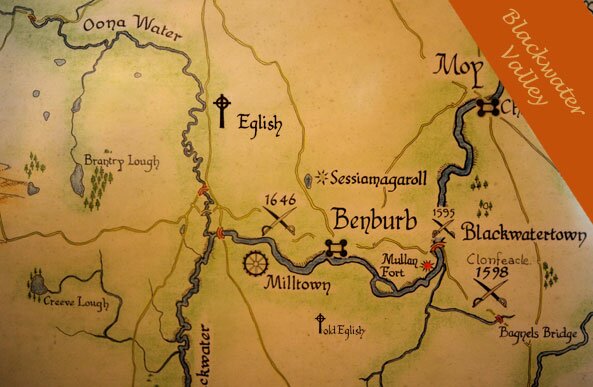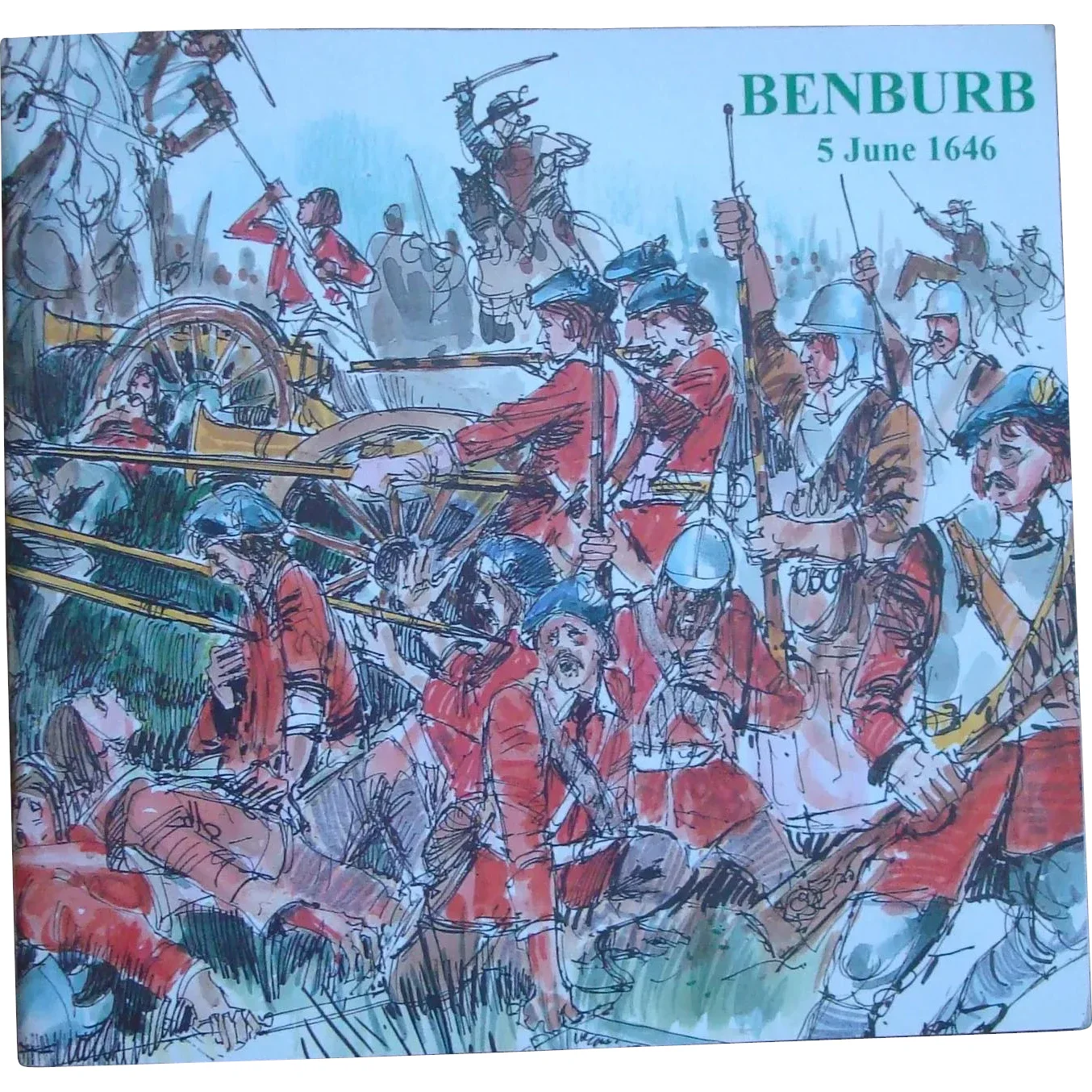Battle of Benburb
Eglish’s long Christian tradition is encapsulated in its very name – derived from the Irish term for ‘the Church’ (An Eaglais) – and events of national importance took place here, not least episodes in connection with the Nine Years War at the end of the sixteenth century and the Battle of Benburb in 1646.
Return of Eoghan Rua O Neill

Owen Roe O Neill, ‘that very brave and noble Irish Chieftain’ (Pope Urban VIII; portrait by Van Brugens)
On 18th July 1642, news of the arrival in Ireland of Eoghan Rua O Neill, with a company of seasoned troops and veterans of continental wars, gave fresh hope to the battle-weary Ulstermen.
Eoghan Rua, a nephew of Hugh, the Earl of Tyrone, had returned from Europe after a brilliant military career in the service of Spain. Having arrived at Doe Castle in north Donegal, he was escorted to Tyrone by a party of 3,000 Ulstermen chosen by Sir Felim. A month later, Sir Felim relinquished his position as General in favor of his more distinguished kinsman. Eoghan immediately set to the work of training what seemed to him no more than an undisciplined rabble. By dint of hard work and the severest discipline, he managed to turn them into an efficient fighting force.
The Battle of Benburb
Charlemont Fort still possessed Sir Felim; the garrison there was able to supply high-grade intelligence to Eoghan Rua about the movements of Monro. Early in the summer of 1646, he learned that Monro, with his full force, was about to march south through Cavan to Kilkenny (CL, page 36).
On 1st June 1646, Monro was at Carrickfergus with an army of 5,000 troops, 800 horsemen and seven field guns. He had ten regiments, at least six of which were well-trained, experienced Scot fighters who were veterans of the wars in Europe. He planned to join with Lord Montgomery of Ards and camped near Pontzpass. At the same time, Colonel George Monro, commander of the horse, was camped in the vicinity of Coleraine with a small detachment of about 240 musketeers and about 300 horsemen. From the Laggan, Sir Robert Stewart was on the move with an army of about 2,000 men and some horses. The plan was that the two Monros should combine at Glaslough and join Stewart at Clones, and this great army of almost 9,000 would proceed against Kilkenny to destroy the Confederation, taking out Eoghan Rua in Cavan and wiping up any other pockets of resistance on the way. It was planned that the Laggan contingent should enter Connacht to support Sir Charles Coote, who had captured Sligo for the Parliamentarians the year before.
At this time, Eoghan Rua had, for the first time, an army of 5,000 well-trained, thoroughly disciplined infantry and about 500 horsemen. His infantry was equal in number to Robert Monro’s. He had not as many horsemen. His men were not as well equipped, their arms were not as good, and he had no field guns, but he was confident of victory against Robert Monro. His tactics since he arrived in Ireland four years earlier were mostly of the guerilla variety. Eoghan Rua had been engaged in serious action only once in that time, and that was on 13th June 1643 at Clones. Because Eoghan Rua was defeated on that occasion, he determined not to engage the enemy forces until he had an army fit enough to meet them on the field. Now was his time.
Monro decided on his move on 1st June Eoghan Rua was made aware of it and immediately set out on the 50-mile march to Benburb. On the ground, he had carefully chosen to give him the best advantage; he could force Robert Monro to face him. His move to Benburb meant that Monro would have to defer his original plan to proceed to Kilkenny because, if he left the Irish at Benburb, the rich settled lands of Antrim and Down, then practically undefended, would have been at the mercy of Eoghan Rua. If he had proceeded, as planned, to Glaslough, he knew that George Monro’s small force would have to pass a little distance to the west of Benburb and would be annihilated by the Irish. Monro was left with no option but to face O Neill.
On the evening of 4th June, Eoghan was at Benburb after a march of 2 to 3 days; and that same evening, Monro was at Poyntzpass. From the heights around Benburb, particularly from Sessiagh Fort, the Irish would have seen the flames and smoke of the enemy campfires as they settled down for the night on the border of Armagh and Down. Monro had no idea that O Neill was anywhere within 50 miles of him. Early on the morning of 4th June, he had sent forward a detachment of seventy-two horses under Lieutenant Daniel Monro with orders to cross the Blackwater about Benburb and advance northward into Tyrone, scour the countryside, meet George Monro and make sure that he was on schedule for the planned meeting at Glaslough. However, near Armagh, this “forlorn hope”, as they were called, encountered what they thought was a forward troop of O Neill’s army. It was actually a scouting party sent out from Benburb. One of them was captured and immediately sent back to Monro at Poyntzpass. Imagine the astonishment of Monro when he learned from the prisoner that his adversary was at Benburb and not in Cavan. His immediate concern was for the safety of the Coleraine force that was marching straight into the clutches of O Neill. He may have thought, too, that the main body of the Irish had not yet reached Benburb and would still be marching across his path and could be crushed if he hurried. Immediately he ordered his army to move off a further 8 to 10 miles to Hamiltownsbawn. In confusion, O Neill’s scout escaped and arrived safely at Benburb with precise information about the disposition of the Monro army, which reached Hamiltonsbawn about 9 or 10 o’clock. So great was the urgency they were on the march again about 4 the following morning on their way towards Armagh, where they learned that Eoghan Rua’s entire army had spent the night at Benburb, having almost certainly reached that place by the left bank of the river and not by the right (or Armagh side) as Monro had anticipated.

Battle Of Benburb
Monro, in full view of his enemy, rode out to Benburb with a few officers to view for himself the disposition of the Irish army. When he saw the position of the Irish and the fords between there and Charlemont guarded by them, he decided not to make a frontal attack and, as Friar O Mellan informs us, decided to proceed towards Tynan. The main body was signaled to move in that direction. He knew, however, and Eoghan Rua knew too that he would have to gain the Tyrone side of the Blackwater somewhere southwest of Benburb. With the aid of the Coleraine force, he was confident of a victory. Eoghan Rua, however, having been informed by his scout of George Monro’s approach, took immediate steps to level the odds. Early that morning, he despatched Colonel Brian Rua O Neill with the greater part of the cavalry and some foot to intercept and eliminate the Coleraine column.
Early in the afternoon, when Eoghan Rua saw the first regiment of Scot’s horses crossing the Blackwater, he was sure that Monro was going to engage him, but he would not be lured from the ground of his own choosing. Monro would have to come to him. He ordered his own regiment of foot and a troop of horse to cross the Oona and lie in wait for the Scots advance guard at the wooded pass of Ballaghkilgevill on the further side of the Oona and slow their progress and thus “buy time” for Brian Rua to complete his mission.
Monro Delayed

The illustration is taken from: Benburb 5th June 1646, by Douglas Carson.
Monro, forced to march his army upriver, found a suitable crossing place near Caledon. It was the early afternoon, and his men got a brief rest while the supply train was being secured in the vicinity of the Dyan. From there, his way to the Oona was across rough and difficult terrain, which added to the weariness of his heavily-armed men. The only option was to veer away from the Blackwater and take the high ground as he could see that Knocknacloy Hill was occupied by O Neill’s men. His line of march would take him to the west side of Tullygiven lough, where his advance guard encountered Colonel Richard Farrell with the Irish cavalry and a considerable force of infantry. The ensuing battle caused considerable delay, which gave a further welcome rest to Monro’s weary foot soldiers in the rear. Reinforcements were brought up, and a push was made past Tullygiven lough to the gorge at Ballaghkillgevill, where both sides “saluted one another very roughly”. When sufficient delay was caused, Farrell and his men suddenly returned to their lines.
During the skirmish at Ballaghkilgevill Eoghan O Neill had marched the remainder of his army a mile west of their camp at Benburb towards Drumflugh, where, on what was described as “a scragged high hill”, he arranged them in battle order and awaited the enemy who were forced to draw up their lines on the opposite hill of Derrycreevy. Between these hills is a little valley through which, in those days, a considerable stream flowed southwards into the Blackwater. Today it flows under the roadway where it forms the eastern boundary of the farmland of William Irwin. That stream, the west-east course of the Blackwater at this point and the constricted nature of Derrycreevy Hill were crucial to the outcome of the battle, which got underway about 7.30 p.m. after Brian Rua returned intact after dispersing the Coleraine force. By 10.30 p.m., the battle was over. O Mellan deals concisely with the whole action from Monro’s arrival to reconnoiter at Benburb until the lost and wounded were tallied.
After The Battle
Among the officers killed on Monro’s side was Lord Blayney of Castleblayney, who was captain of the artillery, and Captain James Hamilton of Newcastle. By order of Eoghan Rua, these two bodies were buried the next day beneath the floor of St. Patrick’s Church in Benburb, an indication of the social standing of these men and their families. Blayney was later exhumed for reburial in Castleblayney. In The Hamilton Manuscripts, a “decent tomb” was erected over Hamilton and can be seen against the east gable of the church, apparently above the spot where Captain Hamilton’s remains resting. It bears the following inscription:
Here lyeth body of the captain
JAMES HAMILTON late of new
Castle in the County of Down
Son and heir of William Hamilton
of Newcastle in the said County
Esq Brother to the R Hon the
Lord Viscount Claneboy the
Said JAMES was slain in his
MAJESTYS service against
The Irish Rebels near Ben-
burb the fifth day of June
1646
Vivit post funera Virtus
Captain Hamilton’s regiment of foot was among those routed, and the captain himself, according to tradition, met his death while trying to escape to “Tullyrean”. This place may have been Tullyremon, a short distance south of Tullygiven lough and not Tullylearn “lying between Benburb and Blackwatertown”, as previously claimed. By heading to Tullyremon rather than Tullylearn, he would have been leaving the Irish behind him and, perhaps, making for the Blackwater crossing, which he had used on his way to Benburb.
Unlike officers, common soldiers were not normally taken prisoner, and it is a measure of Eoghan Rua’s humanity that a detachment of 150 taken early in the day during the skirmish with Henry O Neill were given safe conduct the next day to Poyntzpass from where they could continue in safety.
📎 Related Articles
1. The Historic Journey of Manchester Visiting Nurse Association
2. The SS Cody Victory: A Chronicle of Maritime History
3. Historical Periods: A Comprehensive Exploration for Students
